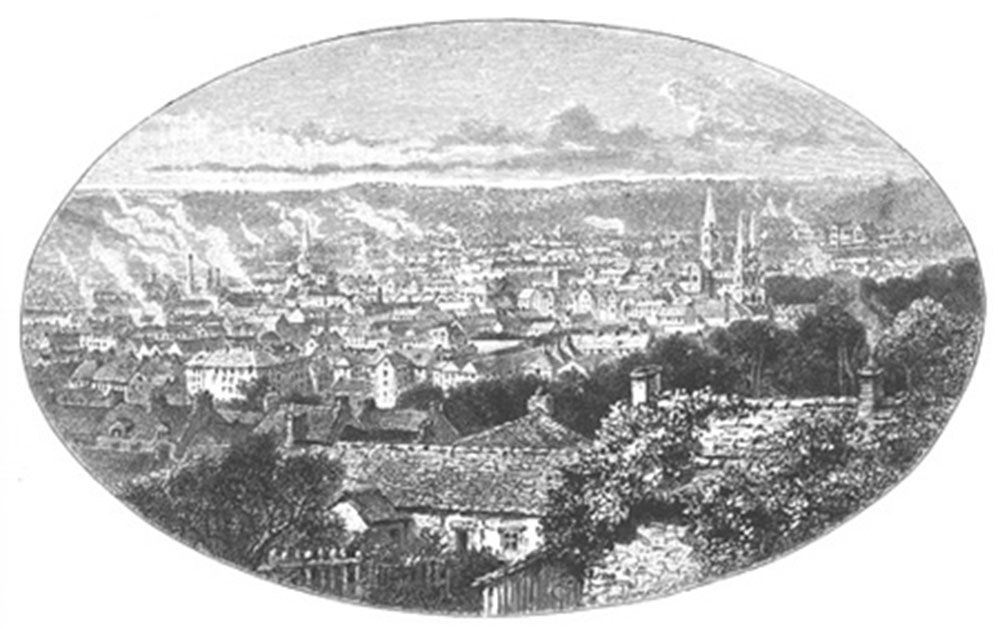Cork - Irish Pictures (1888)
From Irish Pictures Drawn with Pen and Pencil (1888) by Richard Lovett
Chapter IV: From Dublin to Cork … continued
« Previous Page | Start of Chapter | Book Contents | Next Page »
After leaving Cashel there is not much of very special interest until Cork is reached. From the train fine views of the Galty Mountains are obtained, especially in the early part of the year, when the snow is lying in the gullies, and crowning the summits. But for the most part the gently-undulating country is devoid of attractiveness. Queenstown, Youghal, and Kilcolman are places that make demands upon the attention, and as they are all easily reached from Cork, we may best visit them after we have seen that city.
The metropolis of Southern Ireland is a city of 80,000 inhabitants, well situated on the banks and in the valley of the Lee. It is a great port, and also the centre of the butter trade for South-western Ireland. Provisions and grain are also exported in considerable quantities. There are many evidences of trade and busy life in the city; but there are also those signs of depression so common in Irish towns. Empty and ruined houses may be seen in or near the main thoroughfares; and, busy as the streets and wharves undoubtedly are, they yet do not convey the impression of being utilized up to the full measure of possibility.
Cork produces strangely mixed impressions upon the stranger. Looked at as a whole from one of the heights commanding the city, the impression is pleasing. Some of the streets, as for example, the Grand Parade, George's Street, the South Mall, and Patrick Street are fine wide thoroughfares, filled with well-stocked shops, handsome buildings, and well-dressed people intent upon business. The quays and the bridges, six in number, are also fine and commodious, the most noteworthy being St. Patrick's and Parnell's, the latter a fine swivel bridge, opened in 1882. But many of the other streets are narrow, irregularly built, and not at all inviting to the passer-by. Still Cork ought to be estimated as a great sea-port, and judged on these lines it is perhaps ungracious to find much fault.
The city possesses some very handsome buildings, notably the Cathedral of St. Fin Barre, which stands on the site of an ancient monastery, and was consecrated in 1870. This magnificent building is an example of what can be done by the energy of one man. The late bishop, John Gregg, obtained the money, laid the foundation stone, consecrated the building, and arose from his bed, only a few weeks before his death, to place the top stones upon the towers and the spire. The Roman Catholic Cathedral is a handsome structure, and Trinity Presbyterian Church is one of the architectural ornaments of the town.
One of the Queen's Colleges is situated in Cork. In the churchyard of St. Anne's at Shandon, lie the remains of Father Prout, near the spot he loved, and within sound of those bells of which he wrote:—
With deep affection
And recollection
I often think of
These Shandon bells,
Whose sound so wild would,
In the days of childhood,
Fling round my cradle
Their magic spells.
On this I ponder
Where'er I wander,
And thus grow fonder,
Sweet Cork, of thee;
With thy bells of Shandon
That sound so grand on
The pleasant waters
Of the River Lee.
I've heard bells chiming
Full many a clime in,
Tolling sublime in
Cathedral shrine,
While at a glib rate
Brass tongues would vibrate—
But all their music
Spoke naught like thine;
For memory dwelling
On each proud swelling
Of thy belfry knelling
Its bold notes free,
Made the bells of Shandon
Sound far more grand on
The pleasant waters
Of the River Lee.
The easiest, and in some respects the pleasantest, excursion from Cork is a visit to Queenstown, or, as it used to be called, the Cove of Cork. The most enjoyable way is to go by steamer, but the trip by rail affords good views of the finest scenery. For some miles the route lies along the river, which soon begins to widen out into a very fine stream. On the north bank the land rises rapidly to a considerable elevation, and is very well wooded. The citizens of Cork have not been slow to avail themselves of the fine sites thus afforded for comfortable residences, and many fine houses adorn both the north and south shores. A conspicuous landmark upon the southern bank is Blackrock Castle, a modern building, situated upon a promontory at a bend in the river, which here turns sharply to the south, and broadens into a fine estuary. The railroad to Queenstown runs along the north shore, while the Cork and Passage railway occupies the southern.
« Previous Page | Start of Chapter | Book Contents | Next Page »

